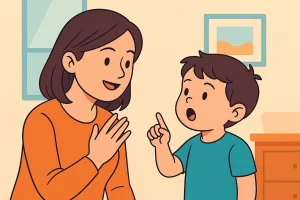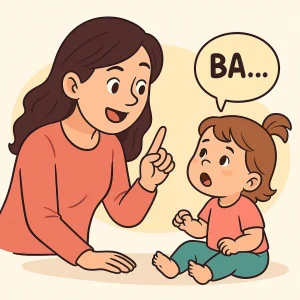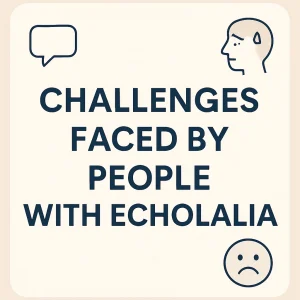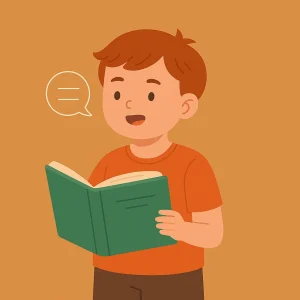Do Children Outgrow Apraxia? What You Need to Know
Last Updated: June 14, 2024
Childhood apraxia of speech (CAS) is a condition that can be challenging for both children and their parents. As a parent, it’s natural to have many questions about your child’s development and what the future might hold. One of the most common concerns is, “Can children outgrow apraxia?” Understanding this condition and the possible outcomes can help you navigate the best path forward for your child.
Childhood apraxia of speech is a motor-planning disorder where the brain has difficulty coordinating the movements needed for speech. Unlike other speech delays, children with CAS know what they want to say, but their brain struggles to send the correct signals to their mouth muscles. This results in difficulty forming sounds, syllables, and words correctly.
Understanding Childhood Apraxia of Speech
Childhood apraxia of speech (CAS) is a motor-planning disorder that affects a child’s ability to produce clear and consistent speech. Unlike other speech disorders, CAS is not about the muscles themselves but rather the brain’s difficulty in coordinating the movements required for speech. This makes it challenging for children to form sounds, syllables, and words correctly, even though they know what they want to say.
How CAS Affects Speech Motor Planning
In CAS, the brain struggles to send the correct signals to the mouth muscles needed for speech. This miscommunication results in difficulty coordinating the movements necessary to produce speech sounds accurately. For instance, a child might be able to say a word correctly once but struggle to repeat it consistently. This inconsistency is a hallmark of apraxia, making it distinct from other speech issues.
Differentiating CAS from Other Speech Disorders
It’s essential to understand how CAS differs from other common speech disorders:
- Speech Delay: A speech delay means a child is developing speech and language skills more slowly than their peers. However, their speech follows the typical development pattern, just at a delayed pace. Children with a speech delay often catch up with appropriate intervention.
- Speech Sound Disorders: These include articulation and phonological disorders. In articulation disorders, a child consistently makes incorrect sounds, such as saying “wabbit” instead of “rabbit.” Phonological disorders involve patterns of sound errors, like consistently dropping the final consonants in words.
Comparison of Speech Disorders
| Feature | Childhood Apraxia of Speech (CAS) | Speech Delay | Articulation Disorder |
|---|---|---|---|
| Cause | Motor planning issues | Late speech development | Incorrect sound production |
| Consistency of Errors | Inconsistent | Consistent with delay | Consistent, specific errors |
| Speech Development Pattern | Atypical | Typical but delayed | Typical but incorrect |
| Speech Production | Struggles with coordinating movements | Follows normal milestones but slower | Makes specific sound errors repeatedly |
| Intonation and Rhythm | Often disrupted | Usually normal | Typically normal |
| Groping for Sounds | Yes, frequently | No | No |
| Speech Clarity | Poor, variable | Generally clear once words are produced | Specific sounds are unclear |
| Requires Therapy | Yes | Often | Yes |
| Need for Alternative Communication Methods | Sometimes, depending on severity. | Rarely | Rarely |
| Common Therapy Techniques | Visual prompts, tactile cues, auditory feedback | General speech development techniques | Focused on correcting specific sounds |
Also read: What is the Relation between Communication, Speech and Language? | Speech and Language Therapy
Signs and Symptoms of Childhood Apraxia of Speech
Recognizing the signs and symptoms of childhood apraxia of speech (CAS) early can make a significant difference in getting the right support and intervention for your child. Here are some key indicators to watch for:
Inconsistent Errors in Speech
Children with CAS often exhibit inconsistent speech errors. This means that they might pronounce the same word differently each time they attempt to say it. For example, your child might say “cat” clearly one day but struggle to produce the same word correctly the next day. This inconsistency can be confusing and is a hallmark of apraxia.
Difficulty with Sound and Syllable Production
Producing sounds and syllables correctly is a common challenge for children with CAS. They might know the word they want to say but have difficulty coordinating their mouth movements to form the correct sounds. Longer and more complex words often pose even greater difficulty, leading to speech that is hard to understand.
Groping for Sounds
You might notice your child appearing to “grope” for the correct sounds as they speak. This involves visible effort and a struggle to position their mouth correctly to produce specific sounds. They may repeat parts of words or sounds, trying to get them right. This groping is another characteristic sign of apraxia and can be frustrating for both the child and the listener.
Issues with Intonation, Stress, or Rhythm of Words
Children with CAS often have trouble with the natural rhythm and flow of speech. They might place stress on the wrong syllables or pause inappropriately within or between words. Their speech may sound choppy or monotone, lacking the normal intonation patterns that make speech sound natural.
Know more about on Speech Sound Disorders: Causes, Treatment and Strategies
Why Recognizing These Signs is Important
Early recognition of these signs and symptoms is crucial for getting your child the help they need. If you suspect your child might have apraxia, consulting with a speech-language pathologist (SLP) for an evaluation is the next best step. An SLP can provide a detailed assessment and develop a tailored treatment plan to address your child’s specific needs.
Diagnosis and Assessment
Diagnosing childhood apraxia of speech (CAS) is a crucial step in getting the right support and intervention for your child. Understanding how CAS is diagnosed and the importance of early diagnosis can help you take timely action.
How CAS is Diagnosed by Speech-Language Pathologists
A speech-language pathologist (SLP) is the professional who typically diagnoses CAS. The process involves several steps to ensure an accurate assessment:
- Comprehensive Evaluation: The SLP conducts a detailed evaluation, which includes gathering a thorough case history. They will ask about your child’s developmental milestones, family history of speech or language disorders, and any other relevant medical information.
- Observation and Interaction: The SLP will observe your child’s speech in different contexts, such as during play, conversation, and structured tasks. This helps to identify patterns of speech errors and other characteristics of CAS.
- Standardized Tests: These tests are used to assess your child’s speech sound production, motor planning abilities, and overall language skills. The tests are designed to compare your child’s performance with that of typically developing children of the same age.
- Speech Tasks: The SLP will ask your child to perform specific speech tasks, such as repeating words and phrases of increasing length and complexity. They will also look for signs of inconsistent errors, groping, and difficulty with prosody (intonation, stress, and rhythm).
- Differential Diagnosis: The SLP will differentiate CAS from other speech disorders, such as phonological disorders or articulation disorders, by analyzing the type and nature of speech errors.
Importance of Early Diagnosis
Early diagnosis of CAS is critical for several reasons:
- Timely Intervention: Identifying CAS early allows for the prompt initiation of speech therapy, which is essential for improving speech outcomes. The earlier therapy begins, the better the chances of significant progress.
- Customized Treatment Plans: Early diagnosis enables the development of a tailored treatment plan that addresses the specific needs of your child. This personalized approach ensures that therapy is as effective as possible.
- Parental Support and Involvement: Knowing your child’s diagnosis early helps you understand their challenges and how you can support them. Being involved in the therapy process and practicing at home can make a big difference in your child’s progress.
- Educational Planning: Early diagnosis allows for the appropriate planning and support within educational settings. Schools can provide necessary accommodations and support services to help your child succeed academically and socially.
Read more: Early Identification/ Warning Signs in child development.
Treatment for Childhood Apraxia of Speech
The primary treatment is speech therapy once a child is diagnosed with childhood apraxia of speech (CAS). This therapy is essential for helping children improve their speech and communication skills.
Overview of Speech Therapy as the Primary Treatment
Speech therapy is the cornerstone of treatment for CAS. Unlike other speech disorders that might improve with age, children with CAS typically need targeted intervention to see progress. Speech therapy focuses on helping children learn the correct motor patterns needed for speech.
Different Types of Speech Therapy Techniques Used
To effectively treat CAS, speech-language pathologists (SLPs) employ various techniques tailored to each child’s needs. Here are some of the most commonly used methods:
Visual Prompts
Visual prompts involve showing children how to produce specific sounds using visual aids. For example, an SLP might use mirrors to help a child see the movements of their mouth and lips. Watching the SLP demonstrate the sounds can also help children understand the correct way to form words.
Tactile Cues
Tactile cues involve physical touch to guide the child in producing the correct sounds. An SLP might gently touch a child’s face or lips to indicate where and how they should position their mouth. These tactile prompts can be incredibly effective in helping children feel the correct movements needed for speech.
Auditory Feedback
Auditory feedback helps children with CAS by allowing them to hear the differences between correct and incorrect sounds. An SLP might record the child’s speech and play it back, highlighting the areas that need improvement. This feedback helps children become more aware of their speech patterns and work towards correcting them.
Importance of Frequent and Consistent Therapy Sessions
For children with CAS, frequent and consistent therapy sessions are crucial. Many experts recommend at least three to five sessions per week, especially during the initial stages of treatment. Regular practice and repetition are key to helping children develop and reinforce the correct motor patterns for speech.
Consistency at home is also important. Parents can support their child’s progress by practicing the techniques learned in therapy sessions and incorporating speech exercises into daily routines.
Alternative Communication Methods
While children with childhood apraxia of speech (CAS) work on improving their verbal communication through speech therapy, alternative communication methods can be vital. These methods help children express their needs and thoughts, reducing frustration and enhancing their ability to interact with others. Here are some effective temporary methods to assist communication:
Sign Language
Sign language can be an excellent tool for children with CAS. It allows them to communicate using gestures and signs, bypassing the need for verbal speech. Teaching your child basic signs for common words and phrases can help them convey their needs effectively. For example, signs for “more,” “eat,” “drink,” and “help” can be quickly learned and used in everyday situations.
Picture Books
Picture books or communication boards are another useful method. These tools involve using images to represent words or phrases, enabling children to point to pictures to express themselves. For instance, a picture book might have images of common items like food, toys, and activities. By pointing to these pictures, children can communicate their preferences and needs. This method is particularly helpful for young children or those who have difficulty with sign language.
Augmentative and Alternative Communication (AAC) Devices
AAC devices range from simple communication boards to sophisticated electronic devices. These tools provide a way for children with CAS to communicate more complex ideas. Here are some examples:
- Communication Boards: These are simple boards with pictures or symbols that the child can point to. They are easy to use and can be customized to include pictures relevant to the child’s daily life.
- Portable Tablets: Tablets equipped with specialized apps can help children communicate by selecting pictures or typing words that the device then vocalizes. These apps often include a wide range of vocabulary and can be tailored to the child’s specific needs.
- Speech-Generating Devices: These electronic devices produce speech when the child selects words or symbols. They can be highly customizable and offer a robust communication solution for children with severe speech impairments.
Using these alternative communication methods can significantly aid children with CAS as they work on their speech. While these tools might not be needed long-term, they provide essential support in the interim, helping children communicate effectively and reducing frustration.
Explore more on our article: Augmentative and Alternative Communication (AAC)
Factors Affecting the Prognosis
When it comes to childhood apraxia of speech (CAS), several factors influence the prognosis and overall outcomes for children. Understanding these factors can help parents and caregivers set realistic expectations and tailor support effectively.
Individual Variations in Response to Therapy
Every child with CAS is unique, and their response to speech therapy can vary widely. Some children may show rapid improvement with consistent therapy, while others might progress more slowly. Factors such as the severity of the apraxia, the child’s age at the start of therapy, and their overall engagement in the therapy process play crucial roles. It’s important to recognize that progress can be uneven, with periods of significant gains followed by plateaus.
The Role of Early Intervention in Improving Outcomes
Early intervention is critical in managing CAS. The sooner a child begins receiving speech therapy, the better their chances of making significant improvements. Early therapy helps children develop the correct motor patterns for speech, reducing the risk of developing maladaptive habits. Additionally, starting therapy early can boost a child’s confidence and reduce frustration associated with communication difficulties.
Parents should seek a speech-language pathologist (SLP) as soon as they notice signs of CAS. Early diagnosis and intervention are key to maximizing the effectiveness of treatment and supporting the child’s long-term communication skills.
The Impact of Other Health Conditions
Other health conditions can influence the prognosis of children with CAS. For instance:
- Autism Spectrum Disorder (ASD): Children with both CAS and ASD may face additional communication challenges. However, tailored speech therapy that addresses both conditions can lead to positive outcomes.
- Cerebral Palsy (CP): This motor disorder affects movement and muscle coordination, which can complicate speech development. Children with both CP and CAS may require more intensive and specialized therapy.
- Epilepsy: Seizures and related brain activity can impact speech and language development. Children with epilepsy may need coordinated care involving neurologists and SLPs to manage both conditions effectively.
Parental Support and Involvement
Parental support plays a crucial role in the progress of children with childhood apraxia of speech (CAS). Here’s how parents can actively support their child’s journey:
How Parents Can Support Their Child’s Progress
Parents are integral to their child’s success in overcoming the challenges of CAS. By being involved and proactive, parents can make a significant difference in their child’s progress. Here are some effective ways parents can support their child:
Encouraging Consistent Practice at Home
Consistent practice at home is essential for reinforcing the skills learned during speech therapy sessions. Here are some tips for effective practice:
- Daily Practice: Set aside time each day for speech exercises. Short, frequent practice sessions are more effective than occasional long sessions.
- Incorporate Play: Make practice fun by incorporating speech exercises into playtime. Use games, toys, and activities that your child enjoys to keep them engaged.
- Use Visual and Tactile Cues: Reinforce the techniques used in therapy by using visual prompts and tactile cues at home. For example, use mirrors to help your child see how to form sounds or gently touch their lips to guide mouth movements.
- Create a Routine: Establish a consistent routine for speech practice. This helps your child understand the importance of regular practice and builds a habit of working on their speech skills.
Emotional and Psychological Support for the Child
Supporting the emotional and psychological well-being of a child with CAS is just as important as working on their speech. Here’s how parents can provide this crucial support:
- Encouragement and Praise: Celebrate your child’s efforts and successes, no matter how small. Positive reinforcement boosts their confidence and motivation.
- Patience and Understanding: Understand that progress may be slow and challenging. Be patient and provide a supportive environment where your child feels safe to practice and make mistakes.
- Communication and Involvement: Keep open lines of communication with your child’s speech-language pathologist (SLP). Stay involved in the therapy process and ask for updates on your child’s progress and ways you can help at home.
- Addressing Frustration: Children with CAS may feel frustrated when they struggle to communicate. Teach them coping strategies to manage their frustration, such as taking deep breaths or using alternative communication methods when needed.
Key Points for Parental Support
| Support Area | Description |
|---|---|
| Consistent Practice | – Set daily practice routines – Incorporate play into practice sessions – Use visual and tactile cues learned from speech therapy |
| Emotional Support | – Encourage and praise your child’s efforts – Be patient and understanding of their struggles – Address frustration by teaching coping strategies, like deep breathing or taking breaks |
| Involvement in Therapy | – Communicate regularly with speech-language pathologists (SLPs) – Understand the therapy techniques used in sessions – Practice therapy techniques at home to reinforce learning |
Will My Child Ever Outgrow Apraxia?
As a parent, it’s natural to wonder, “Will my child ever outgrow apraxia?” Addressing this core question requires a realistic perspective, understanding that while significant improvement is possible, some children may need long-term support.
Addressing the Core Question with a Realistic Perspective
Childhood apraxia of speech (CAS) is a complex condition, and each child’s journey is unique. Some children with CAS may show remarkable progress with early and consistent speech therapy. These children can develop clearer and more fluent speech, often reaching a level where their communication is much more understandable. However, it’s important to recognize that CAS is typically a persistent condition, and “outgrowing” it entirely without any intervention is unlikely.
Significant Improvement and Long-Term Support
While many children with CAS can make significant strides in their speech abilities, others may require ongoing support. Progress can vary greatly from one child to another, depending on several factors, including the severity of the apraxia, the presence of other health conditions, and the consistency of therapy.
For some children, speech therapy might lead to substantial improvement, allowing them to communicate effectively with minimal difficulty. For others, ongoing therapy and alternative communication methods might be necessary to support their speech development and overall communication skills.
Importance of Individualized Treatment Plans
The key to effective treatment and support lies in individualized treatment plans. Each child with CAS has unique needs and challenges, so their therapy should be tailored to address these specific aspects. Speech-language pathologists (SLPs) develop personalized treatment plans that focus on the child’s strengths and areas needing improvement. These plans often include a combination of speech therapy techniques, home practice, and alternative communication methods as needed.
Parents and caregivers play a vital role in this process by working closely with SLPs, encouraging consistent practice at home, and providing emotional support. By understanding that progress may be gradual and varied, families can better manage their expectations and support their child’s journey.
Conclusion
In conclusion, while children with childhood apraxia of speech (CAS) may not “outgrow” the condition without intervention, speech therapy can lead to significant improvements. Early diagnosis and consistent treatment are essential for helping children develop their communication skills. Seeking the expertise of a speech-language pathologist as soon as signs of CAS are noticed allows for tailored treatment plans that address the unique needs of each child.
At Wellness Hub, we understand the challenges faced by parents and children dealing with CAS. Our resources and expert advice are designed to support you every step of the way. From early diagnosis to ongoing treatment, we offer guidance and tools to help your child succeed. For more information, visit our website and explore the various services we provide to assist families in managing childhood apraxia of speech. Early and consistent intervention can lead to remarkable progress, helping your child become the best communicator they can be.
Frequently Asked Questions:
1. What is childhood apraxia of speech (CAS)?
Childhood apraxia of speech (CAS) is a motor speech disorder where children have difficulty coordinating the movements needed for speech. They know what they want to say but struggle to make the right sounds.
2. How is CAS different from other speech disorders?
CAS differs from other speech disorders because it involves issues with motor planning. Unlike speech delays or articulation disorders, children with CAS have inconsistent speech errors and trouble with sound and syllable production.
3. What are the common signs and symptoms of CAS?
Common signs of CAS include inconsistent speech errors, difficulty with sound and syllable production, groping for sounds, and problems with intonation, stress, or rhythm of words.
4. How is childhood apraxia of speech diagnosed?
CAS is diagnosed by a speech-language pathologist (SLP) through a comprehensive evaluation that includes observing the child’s speech patterns, conducting standardized tests, and performing specific speech tasks to identify motor planning issues.
5. Why is early diagnosis of CAS important?
Early diagnosis of CAS is crucial because it allows for the prompt start of speech therapy, which is essential for improving speech outcomes. Early intervention helps children develop the correct motor patterns for speech.
6. What are the treatment options for CAS?
The primary treatment for CAS is speech therapy. Techniques used include visual prompts, tactile cues, and auditory feedback. Frequent and consistent therapy sessions are key to making progress.
7. Can children with CAS use alternative communication methods?
Yes, while working on their speech, children with CAS can use alternative communication methods like sign language, picture books, and augmentative and alternative communication (AAC) devices to help express themselves.
8. Will my child ever outgrow apraxia?
While children with CAS may not “outgrow” the condition without intervention, many can make significant improvements with early and consistent speech therapy. Some children might need long-term support, but individualized treatment plans can help them achieve better communication skills.
9. How can parents support their child with CAS?
Parents can support their child with CAS by encouraging consistent practice at home, providing emotional and psychological support, and staying involved in the therapy process. Positive reinforcement and patience are crucial.
10. What role do other health conditions play in the prognosis of CAS?
Other health conditions like autism, cerebral palsy, and epilepsy can influence the prognosis of CAS. These conditions might require more intensive and specialized therapy to address the combined challenges.
About the Author:
Anuradha Karanam
Speech-language pathologist (7+ years of experience)
Anuradha Karanam is a skilled speech-language pathologist with over 6 years of experience. Fluent in Tamil, Telugu, Hindi, and English, she specializes in parent counseling, speech sound disorders, fluency assessment, and speech-language evaluations. Anuradha excels at working with children with developmental disorders, offering creative and effective therapy programs. Currently, at Wellness Hub, she holds a BASLP degree and is registered with the RCI (CRR No A85500). Her patience, ambition, and dedication make her a trusted expert.
Connect with Anuradha to learn more about how she can help you or your loved one find their voice.
Book your Free Consultation Today
Parent/Caregiver Info:
Client’s Details:
* Error Message









